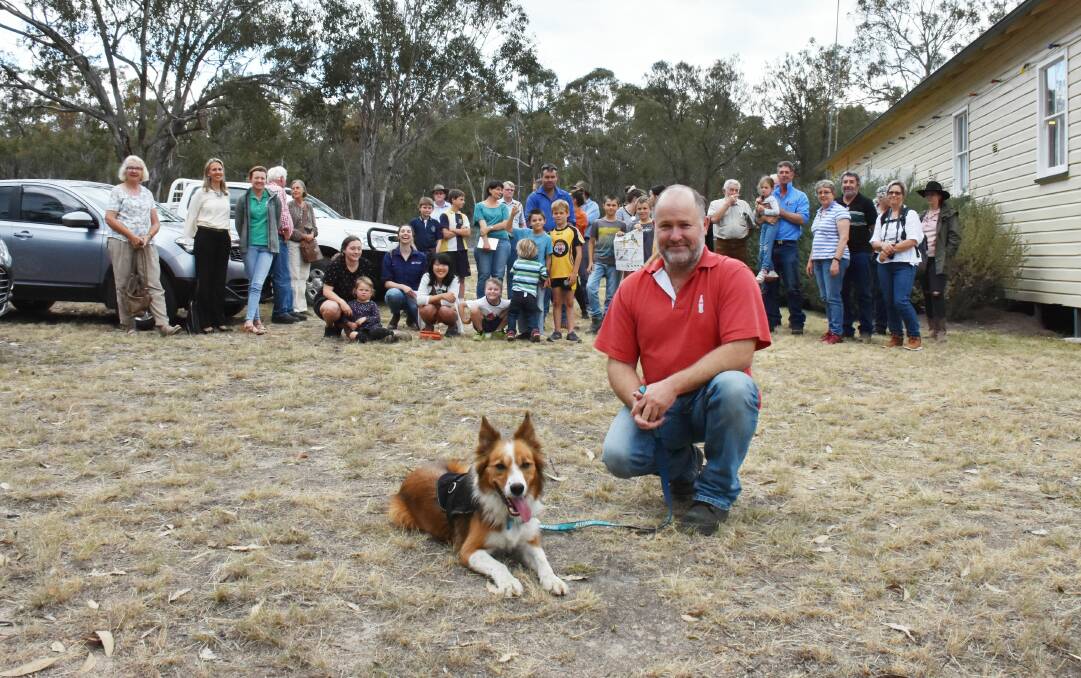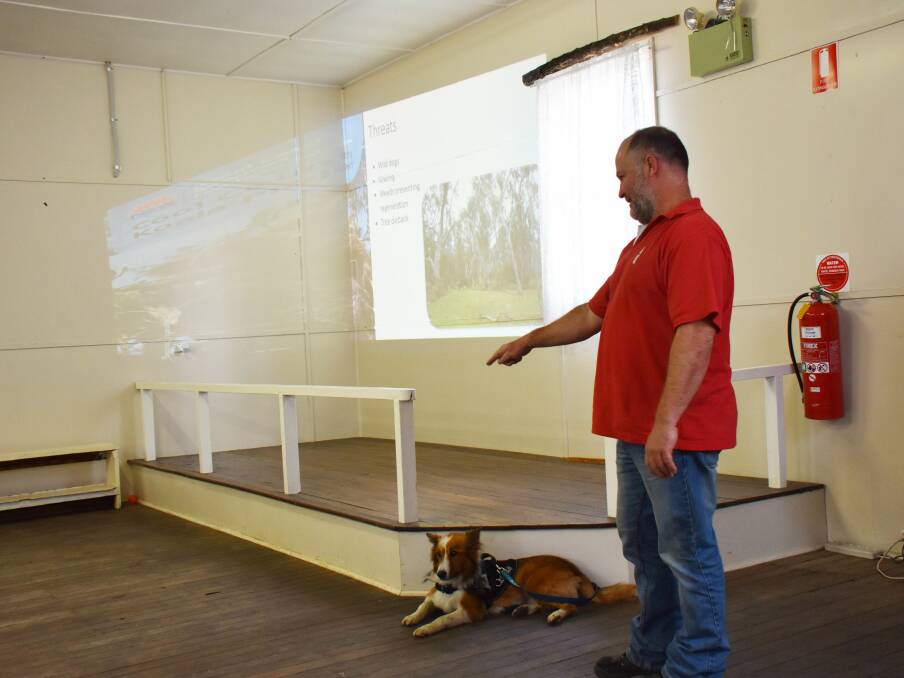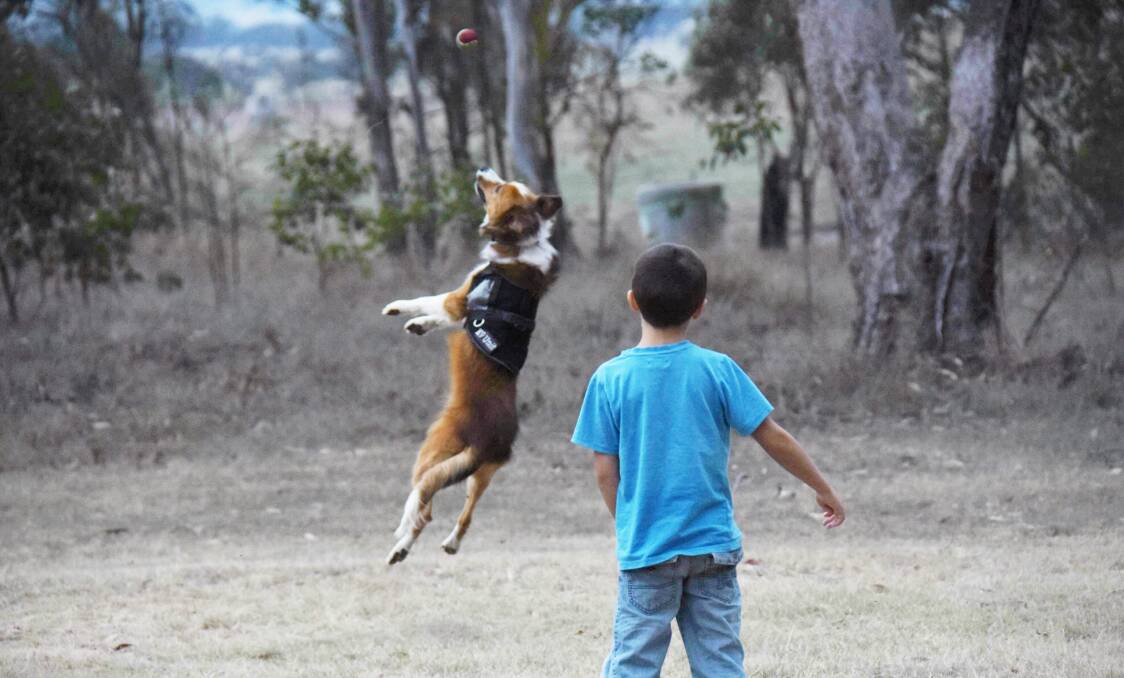
Baxter the koala scat sniffer and his handler Russell Miller from the University of Sunshine Coast impressed a gathering at Sunnyside Hall (outside Tenterfield) on Tuesday, November 20 with their knowledge of all things koala.
Subscribe now for unlimited access.
$0/
(min cost $0)
or signup to continue reading
The duo are in the Northern Tablelands district surveying koala populations to help determine the best tools to support this threatened species.
The project seeks to involved the public, reporting sightings of koalas or, more commonly, their scat (bullet-shaped around 1.5 x 0.5 centimetres, but easily confies with the of the brush tailed possum). Mr Miller said the scats smell like eucalyptus, are very dense and do not contact insect parts, all due to the koala’s diet.
Detection dogs like Baxter can find scats more than a year old.
While there’s anecdotal evidence that koala populations used to be much denser, the project is taking a more scientific approach to determine population numbers and distribution, and anyone spotting evidence of a koala is asked to report it online to the Atlas of Living Australia, or by calling the Northern Tablelands Local Land Services office (02) 6732 8800.
A lot of management decisions are based on where the koalas are, but this information has been lacking in the Northern Tablelands.

Mr Miller also said that a healthy koala will not approach humans, and can sometimes be found sitting at the base of tree, resting its forehead against the bark. In these instances the sighting should also be reported to Northern Tablelands WIldlife Carers (1800 008 290) or WIRES (1300 094 737).
Thanks to the toxins in their diet, Mr Mill said koalas are already living on the edge, naturally. They are considered a vulnerable species, with overall populations are declining everywhere except Victoria (which has other issues).
Threats include loss of habitat, disease (particularly chlamydia), dog attacks and being hit be vehicles).
Mr Miller said surveys comparing population densities now with historic records including falls in the Ashford area and increases around Inverell, although the reason is unclear as the degree of ‘threat’ is similar in both locations.

How to you train a dog to sniff scats?
There was quite a number of school-aged children at the Cool Country Koala workshop at Sunnyside Hall, who had great fun testing Baxter the detection dog’s skills with the ball.
Baxter’s attachment to his ball is actually the device by which he and his workmates are trained for their duties, handler Russell Miller explained.
After the dog’s behaviour to fetch a ball is well-established, the handler throws the ball into increasingly-long grass, forcing the dog to search around for it. Then the ball is covered in scat scent until that behaviour is transferred from the ball to a scat.
Baxter’s reward for finding the koala scat (in double-quick time) that Mr Miller had planted for the demonstration was simply a throw of the ball.
Mr Miller also entertained and educated the kids (and adults) with his rendition of a koala call, with the male’s call very distinct from the females. He said the males are liars, promoting themselves with their deep booming calls as much larger than they actually are. In any case the louder the call the larger the male, and the females gravitate toward him.
Mr Miller had lots of other interesting facts to spike the kids’ interest, including that baby koalas eat their mum’s poo (it’s full of good bacteria), and that the animals are big sleepers in order to digest their toxin-rich diet. They’re also fussy eaters, which makes habitat loss such a threat.
Their home range can be anything from 2-150 hectares, although 50 is average. Mr Miller said despite their rotund appearance koalas are all stomach and no fat, giving them little in the way of reserves.
They have a large gut like a cow, but still need to be able to climb a tree. Also they can’t overeat due to the toxins in the diet, and that’s why they’re already living on the edge.
They can live up to 15 years in the wild, and it’s the young males who are very bold and tend to get reported in the media, finding their way into people’s homes and other unusual places.
Mr Miller said they’re not built for defending themselves, instead extending their limbs to increase their apparent size if they’re caught on the ground, but attacking dogs find them easy to pick off.
Males are around twice the size of females, and can be distinguished by the gland which dirties their chest, and their bigger nose. Mr Miller said every koala has a different face, so they can be individually recognised.
There are fears that climate change is affecting koala populations, with last sightings of a significant numbers of koalas out west coinciding with the the big heat wave of 2009 with its 50 degree plus temperatures.
Mr Miller said the project is finding lots of scats around Wilsons Downfall and Drake, however, so koalas are still around for sharp eyes to find.

